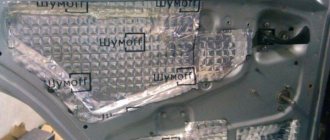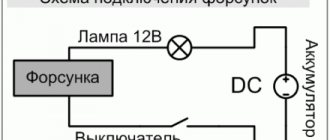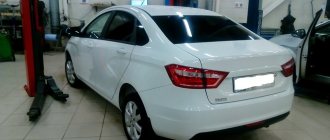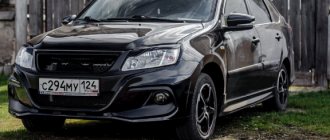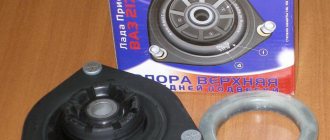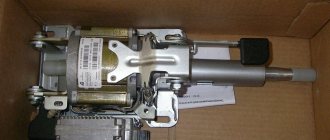In January, AVTOVAZ announced the start of sales of the updated LADA 4×4. The new SUV received a completely new instrument panel with a new climate system, more comfortable seats, the Era-GLONASS system, a number of styling and technical improvements, as well as an improved noise and vibration insulation package on the body panels. Let's find out how much quieter and more comfortable it has become in the interior of the updated Lada 4×4.
An expert from the magazine “Behind the Wheel” compared the noise level inside the cabin of the new Lada 4×4 2021 and the Lada 4×4 of the previous generation (generation).
Basic moments
Niva is very noisy
Do-it-yourself soundproofing of the Niva is carried out using special materials:
- foamed noise-insulating open-cell material with a protective aluminized film, the thickness of which is 12 mm - this material reduces the noise of the Niva from the outside and has a low thermal conductivity coefficient. The noise absorption coefficient can reach 95% in the range of 1000 Hz - 2000 Hz,
- vibration-damping bitumen material with protective aluminum foil, the thickness of which is 2 mm. This material is resistant to aggressive environments,
- vibration-damping bitumen laminate - this is the most effective material from the Noisebuster range, the thickness of which is 4 mm,
- bituminized cardboard with a special vibration-damping layer, 1.5 mm thick,
- vibration-damping bitumen laminate, 2 mm thick.
Do-it-yourself soundproofing of the Niva 21213 interior is done using some tools: scissors, ruler, level, marker or chalk, glue, hand gloves and others.
It should be noted that during the operation of the Niva 2121, 21213 and 21214, the issue of sound insulation quality is transformed into the problem of thermal insulation of the interior of these models. This is explained by the long heating of the interior in the winter and poor air conditioning in the summer.
Sound insulation of NIVA interior
Sound insulation of the floor in Niva - tunnel, engine partition
I didn’t really like my native Shumka. I remove it and send it to the landfill.
The factory Shumka turned into such rubbish in six months. It all fell apart and was soaked in water. This piece was located along the driver's feet. he got the most out of life. If he had lain there for another year, there would definitely be frogs in the car. I throw it away without any doubt or regret
The dashboard was dismantled without much effort. Considering that I did this for the first time in my life.
Based on the remnants of threads from the original Shumka sticking to the body, we can draw a conclusion about its quality and application technology.
Gutted. It probably took 1.5 or 2 hours for all the work. Removing seats and other small items.
The process has begun. The material is SGM 2.3mm (the same as STP standardplast) convenient and practical. Vibration filter. 8mm SPLEN will be glued on top of it.
The process is underway. And ahead is the covering of the rear space. It will probably be very tedious and dreary. And today I am no longer strong and want to sleep. I managed to disassemble and cover everything with vibroplast except the torpedo.
Closer. The tunnel will be glued with another layer of SGM 2.3mm, since the store has run out of special Vizomat (the same SGM only thicker. Special material for particularly noisy areas of cars
It’s like gluing wallpaper in an apartment - it’s quick and convenient on smooth walls, but in corners and behind all sorts of radiators you have to fiddle around, squirming. You'll have to tinker with these tight spots. Stick pieces of caresses into all the curves.
Pasting Splen 8mm. Hn turned out to be not a very pliable material. You need to glue it right away - on the first try. Then you can’t tear it off, unlike 4mm splen - it doesn’t stretch across the surface at all. Most likely because it is glued together from two 4mm sheets, like a wafer, and not monolithic. I tried to sculpt it on flat surfaces, and, of course, on a tunnel.
I hope that the invested forces will live up to expectations, at least by 15 percent, reducing the audibility of the sonorous songs of the handout.
Well, it looks like it's ready. Without going into details, all that remains are the doors and the roof.
Sound insulation of doors and trunk lid
Well, in general, I finally found a garage where I can work on the Shumka Niva.
Since I already said I won’t invest a lot in the car, that’s why I kept the noise to a minimum:
● Doors in 2 layers: 3 sheets of STP (2m), a little bitoplast (contact points). ● Rear trunk door and trim: 4 sheets of STP (2m), 2 sheets of splen 4rka and bitoplast in contact areas.
First I covered it with stp, and then I decided to add 1 more layer of stp and 1 layer of splen up.
There were problems with Movil, namely the doors and trunk were treated very heavily with Movil, I had to wash Movil with white spirit. But in the corners I did not wash the movil and tried not to glue the seams on the movil.
Soundproofing NIVA - removing “crickets” with bitoplast
So, in the fall the floor tunnel was noisy: Vibration insulation - STP Bimast Bomb, Noise insulation - Splen 8mm in two layers. The doors were also made: Vibration insulation - STP Vibroplast Gold, Noise insulation - Splen 8mm. And floor: Vibro-STP Vibroplast Silver, Noise-Splen 8mm.
The effect was good! The door rattling disappeared and the acoustics sounded much richer. There was only one minus - there was no need to throw out the standard Shumka (I can’t say now why I threw it away), it would have been even better).
The main question that haunts us is: “Why do people use Spleen for sound insulation?”
I have come across a lot of posts here on Drive and on YouTube, a bunch of videos and guides on the topic of sound insulation - in most cases, people limit themselves to vibration isolation and put splen on top and call it sound insulation...
After all, it is a heat insulator, not a sound absorber.
No, it would be fine if the goal was to insulate the car... But for sound insulation.
In short, I was also wrong... and it was necessary to correct my mistakes.
To begin with, the following materials were purchased: - Vibroplast Vikar Premium 1.6mm - 11 sheets. — SPLEN 4 mm — 10 sheets. — Bitoplast MA15 K Gold — 6 sheets. — Hermeton 30 mm — 1 sheet.
Then, with the help of my friends, they gutted the car:
Then everything inside was washed from centuries-old dust and degreased with gasoline and acetone.
A layer of 8mm Splen was removed from the floor tunnel and a sheet of Hermeton 30mm was installed (!) This is what I understand - a sound absorber!
Touching him is a pleasure, by the way
The entire Spleen was also torn off from the door cards, its place was taken by Bitoplast MA15 K Gold. The cards were completely covered with it. Naturally, they won’t come back after such an upgrade. A handful of self-tapping screws and a screwdriver corrected the situation, the door cards are now firmly seated and do not even have a single chance to creak)) The doors close with a dull sound, which is quite unusual
This is what the door looks like from the inside at the moment.
Riddle - find 10 screws
Bitoplast itself has a similar structure to sealant
Further, the same material was used to cover all the plastic trims in the cabin: the rear side trims, the trims at the driver’s and passenger’s feet, and the trunk door trim.
The tailgate trim is clearly visible
After working out the mistakes, we began vibration isolation of the remaining part of the cabin.
A little imagination, creativity and work with a construction hairdryer.))
4mm splen and standard sound insulation were laid on top of the Vibra.
At the subwoofer's place of residence, Bitoplast was also laid, it was also tightly screwed with self-tapping screws to the casing and the rod on which it lies.
The box, however, does not look marketable - it will be covered with carpet, the vinyl did not justify itself...
The trunk door was also completely soundproofed.
What we have as a result: - Nothing creaks anywhere, at all. All the crickets were smoked out... to be honest, there was a trunk full of them...)) - It became quieter inside... quieter than after the first attempt at soundproofing. — A noticeable fact is that now half the car does not play to the beat of the subwoofer. It's really nice to listen to music now. — With the music turned up to full volume and the car closed, NOT a single piece of hardware vibrates. Let’s not forget that this is a field, and, therefore, this fact speaks volumes. https://www.drive2.ru/l/288230376152114620/, https://www.drive2.ru/l/288230376152618809/, https://www.drive2.ru/l/4114540/
Luggage compartment
Trunk noise insulation
Almost the entire floor of the trunk, including the back of the rear seat of the Niva 21213, is covered with finishing material in the form of carpet. This material is durable, attractive in appearance and easy to clean. If you dismantle it, you can see a soundproofing mat, the thickness of which is 15 mm. The car's noise insulation is presented in the form of this material, and the manufacturer used mastic as vibration insulation. It covers the floor of the luggage compartment, while its thickness does not exceed 1.5 mm.
The standard sound insulation of the Niva 21213 car is of high quality, but despite the presence of a three-layer cake (mastic, felt and carpet), the manufacturer did not take care of vibration and noise insulation of the arches. As for efficiency, mastic, which is more considered actikor, was used to vibration-proof the luggage compartment floor. The factory-installed sound insulation only covers most of the floor area of this vehicle. Similar noise protection is used in the Niva 2121 model.
To carry out additional sound insulation, the following materials will be required:
- Vibroplast Gold (StP)
- Vizomat MP (StP)
- Accent 15 LM KS (StP)
- Splen 3004 (StP)
- Stroyizol SD 90
- Adgilin.
The tools you will need are: a hair dryer, a square, a ruler, a tape measure, a knife, scissors, screwdrivers, an awl and others.
What to do outside?
Noise insulation of the Chevy Niva or other modifications will be incomplete if you ignore the treatment of the outer part of the bottom. This is due to the fact that various sounds and noises pass through this element, including vibration of the transmission unit, operation of the muffler, and the ingress of road stones.
The specified part of the machine is processed by standard application of layers of material or by applying liquid noise insulation. In any case, you will need an overpass or a garage pit.
- The surface of the bottom of the car is washed with a directed stream of water under pressure.
- After drying, degreasing is carried out.
- Next, glue the prepared pieces of materials according to the instructions, or spray liquid “Shumka”.
- The second option is preferable because it is easier to apply to hard-to-reach places and has a longer service life.
- In addition, the liquid composition is significantly lighter than the sheet components, although more expensive. At the same time, the price will definitely pay off in the final quality.
After proper treatment of all parts of the car, the audibility of the rustling of tires, the knocking of stones, and the operation of the transmission and engine will disappear. Plastic fender liners, if available, are glued along the internal contour with a noise reflector of the “Spleen” type.
Source: newniva.ru
Work performed
The initial soundproofing of a Niva 21213 car with your own hands involves laying vibration-absorbing material Vizomat MP over the entire area of the trunk floor. To do this you will need a hair dryer. This material must be heated until it becomes elastic and flexible. The adjustment of the material to the topography of the protected surface should be carried out quickly and efficiently. Otherwise, the material will become hard again and will not be able to adhere tightly to the surface. When carrying out such work, it should be taken into account that technical holes that allow maintenance and repair of Niva 21213 cannot be sealed.
Insulation under the rear passenger seat involves the use of MP vibroplast. Accent sound insulation with a thickness of 15 mm is attached to it. Since there is no sound insulation of the car on the wheel arches on the passenger compartment side, therefore, “Liquid Locker” anticorrosive agent will need to be installed on the outside of the arches.
Vibroplast Gold sheets are used to soundproof and protect the side walls of the body from noise. Due to the presence of unclosed technological holes on the side members, this material is installed quickly and easily. For do-it-yourself sound insulation, “Accent” sheets with a thickness of 15 mm are used. This material is laminated with foil on the outside, and has an adhesive layer on the inside, which is protected by paper.
Sound insulation of NIVA interior
Sound insulation of the floor in Niva - tunnel, engine partition
I didn’t really like my native Shumka. I remove it and send it to the landfill.
The factory Shumka turned into such rubbish in six months. It all fell apart and was soaked in water. This piece was located along the driver's feet. he got the most out of life. If he had lain there for another year, there would definitely be frogs in the car. I throw it away without any doubt or regret
The dashboard was dismantled without much effort. Considering that I did this for the first time in my life.
Based on the remnants of threads from the original Shumka sticking to the body, we can draw a conclusion about its quality and application technology.
Gutted. It probably took 1.5 or 2 hours for all the work. Removing seats and other small items.
The process has begun. The material is SGM 2.3mm (the same as STP standardplast) convenient and practical. Vibration filter. 8mm SPLEN will be glued on top of it.
The process is underway. And ahead is the covering of the rear space. It will probably be very tedious and dreary. And today I am no longer strong and want to sleep. I managed to disassemble and cover everything with vibroplast except the torpedo.
Closer. The tunnel will be glued with another layer of SGM 2.3mm, since the store has run out of special Vizomat (the same SGM only thicker. Special material for particularly noisy areas of cars
It’s like gluing wallpaper in an apartment - it’s quick and convenient on smooth walls, but in corners and behind all sorts of radiators you have to fiddle around, squirming. You'll have to tinker with these tight spots. Stick pieces of caresses into all the curves.
Pasting Splen 8mm. Hn turned out to be not a very pliable material. You need to glue it right away - on the first try. Then you can’t tear it off, unlike 4mm splen - it doesn’t stretch across the surface at all. Most likely because it is glued together from two 4mm sheets, like a wafer, and not monolithic. I tried to sculpt it on flat surfaces, and, of course, on a tunnel.
I hope that the invested forces will live up to expectations, at least by 15 percent, reducing the audibility of the sonorous songs of the handout.
Well, it looks like it's ready. Without going into details, all that remains are the doors and the roof.
Sound insulation of doors and trunk lid
Well, in general, I finally found a garage where I can work on the Shumka Niva.
Since I already said I won’t invest a lot in the car, that’s why I kept the noise to a minimum:
● Doors in 2 layers: 3 sheets of STP (2m), a little bitoplast (contact points). ● Rear trunk door and trim: 4 sheets of STP (2m), 2 sheets of splen 4rka and bitoplast in contact areas.
First I covered it with stp, and then I decided to add 1 more layer of stp and 1 layer of splen up.
There were problems with Movil, namely the doors and trunk were treated very heavily with Movil, I had to wash Movil with white spirit. But in the corners I did not wash the movil and tried not to glue the seams on the movil.
Soundproofing NIVA - removing “crickets” with bitoplast
So, in the fall the floor tunnel was noisy: Vibration insulation - STP Bimast Bomb, Noise insulation - Splen 8mm in two layers. The doors were also made: Vibration insulation - STP Vibroplast Gold, Noise insulation - Splen 8mm. And floor: Vibro-STP Vibroplast Silver, Noise-Splen 8mm.
The effect was good! The door rattling disappeared and the acoustics sounded much richer. There was only one minus - there was no need to throw out the standard Shumka (I can’t say now why I threw it away), it would have been even better).
The main question that haunts us is: “Why do people use Spleen for sound insulation?”
I have come across a lot of posts here on Drive and on YouTube, a bunch of videos and guides on the topic of sound insulation - in most cases, people limit themselves to vibration isolation and put splen on top and call it sound insulation...
After all, it is a heat insulator, not a sound absorber.
No, it would be fine if the goal was to insulate the car... But for sound insulation.
In short, I was also wrong... and it was necessary to correct my mistakes.
To begin with, the following materials were purchased: - Vibroplast Vikar Premium 1.6mm - 11 sheets. — SPLEN 4 mm — 10 sheets. — Bitoplast MA15 K Gold — 6 sheets. — Hermeton 30 mm — 1 sheet.
Then, with the help of my friends, they gutted the car:
Then everything inside was washed from centuries-old dust and degreased with gasoline and acetone.
A layer of 8mm Splen was removed from the floor tunnel and a sheet of Hermeton 30mm was installed (!) This is what I understand - a sound absorber!
Touching him is a pleasure, by the way
The entire Spleen was also torn off from the door cards, its place was taken by Bitoplast MA15 K Gold. The cards were completely covered with it. Naturally, they won’t come back after such an upgrade. A handful of self-tapping screws and a screwdriver corrected the situation, the door cards are now firmly seated and do not even have a single chance to creak)) The doors close with a dull sound, which is quite unusual
This is what the door looks like from the inside at the moment.
Riddle - find 10 screws
Bitoplast itself has a similar structure to sealant
Further, the same material was used to cover all the plastic trims in the cabin: the rear side trims, the trims at the driver’s and passenger’s feet, and the trunk door trim.
The tailgate trim is clearly visible
After working out the mistakes, we began vibration isolation of the remaining part of the cabin.
A little imagination, creativity and work with a construction hairdryer.))
4mm splen and standard sound insulation were laid on top of the Vibra.
At the subwoofer's place of residence, Bitoplast was also laid, it was also tightly screwed with self-tapping screws to the casing and the rod on which it lies.
The box, however, does not look marketable - it will be covered with carpet, the vinyl did not justify itself...
The trunk door was also completely soundproofed.
What we have as a result: - Nothing creaks anywhere, at all. All the crickets were smoked out... to be honest, there was a trunk full of them...)) - It became quieter inside... quieter than after the first attempt at soundproofing. — A noticeable fact is that now half the car does not play to the beat of the subwoofer. It's really nice to listen to music now. — With the music turned up to full volume and the car closed, NOT a single piece of hardware vibrates. Let’s not forget that this is a field, and, therefore, this fact speaks volumes. https://www.drive2.ru/l/288230376152114620/, https://www.drive2.ru/l/288230376152618809/, https://www.drive2.ru/l/4114540/
Interior tuning: replacing NIVA seats
Seats from Focus 2 for Niva Installing the driver's seat from Focus 2 in Niva Installation
Source: www.spike.su
What makes the most noise in the field?
The car is noisy in almost every way. In the cabin you can hear the rumble of trim elements, the panel and the sound of the engine, which still has the unpleasant knock of the valve mechanism from the classics. The engine is especially loud in the summer, and if you drive with the windows open, it can sometimes be very annoying.
Another noisy part of the car is the arches. Fender liners are not standardly installed on these cars. The dealer offers them as extras. equipment. But the worst thing is that a good echo is created inside the arches, which appears during the noise of the tires on the track. However, this problem is not only Niva.
The noisiest part of the Niva is the transfer gearbox. It is responsible for changing gear ratios to higher and lower ones. The transfer case on the Niva is very noisy, and this is felt most of all on the highway.
Hood treatment
Soundproofing of the Niva begins with finishing the hood, since this is the simplest design. The stages of work are given below:
- open the hood, remove the standard insulation;
- thoroughly wash the surface;
- the dry cover is degreased, areas with corrosion are cleaned, primed, and painted;
- Initially, the vibromaterial is laid (a piece is cut to size, the film is removed, the material is heated, applied in place and rolled with a roller);
- degrease the surface again, glue the sound reflector so that a single piece covers the entire part of the hood, including the stiffeners;
- many recommend using special foil because it is more temperature resistant;
- The engine partition (the shield between the engine and the passenger compartment) is treated in the same way.
Standard soundproofing of car rear doors
After removing the plastic door trim, you can see what the factory has done in terms of soundproofing the doors.
The photo shows the factory sound insulation of the rear door, or to be precise, its almost complete absence. In detail: the dustproof film (black PE film) is covered in cuts and holes, it is attached to the door with adhesive tape, literally in three places. There is simply no need to talk about quality protection. It immediately became clear why the wind was blowing in the cabin. The vibration protection layer is quite large in area and is applied in the central part of the door. Shown in the photo below.
Conclusion: simple and clear. Sound and heat insulation of car doors is mandatory.
